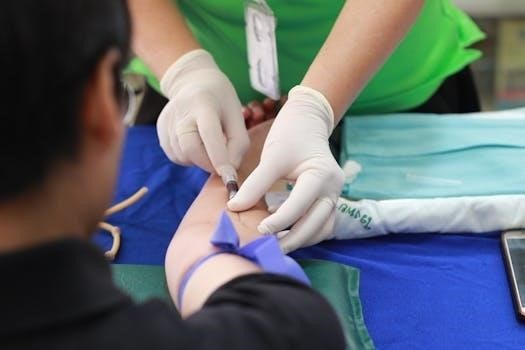The 5th edition of the “Phlebotomy⁚ Worktext and Procedures Manual” is a comprehensive guide for mastering phlebotomy skills. It combines practical instruction with detailed illustrations, offering a complete learning experience. This edition covers all aspects of phlebotomy, ensuring a thorough understanding of the field.
Overview of the 5th Edition
The 5th edition of the “Phlebotomy⁚ Worktext and Procedures Manual” represents a significant update to previous versions, incorporating the latest best practices and technological advancements in the field. This edition aims to provide a comprehensive and user-friendly resource for both students and practicing phlebotomists. It focuses on enhancing practical skills through a combination of detailed textual explanations and clear visual aids. The manual is structured to facilitate step-by-step learning, making complex procedures easier to understand and execute. The content is meticulously curated to align with current industry standards and accreditation requirements. Furthermore, the 5th edition emphasizes patient safety and infection control protocols, which are crucial aspects of phlebotomy practice. This version also includes updated information on various lab tests, ensuring that readers are well-versed in the latest diagnostic techniques. It is designed to be a valuable tool for anyone seeking to master the art and science of phlebotomy. The manual’s overall goal is to prepare individuals for real-world clinical scenarios, fostering competence and confidence in their abilities.
Key Features of the Worktext

The “Phlebotomy⁚ Worktext and Procedures Manual, 5th Edition” is distinguished by several key features designed to enhance the learning experience. A standout aspect is its storyboard format for procedures, which presents each step in a clear, sequential manner, making it easier to grasp the process. The inclusion of detailed illustrations throughout the manual provides visual support, further clarifying the techniques and equipment involved. The worktext also offers focused coverage of current lab tests, ensuring that readers are up-to-date with the latest testing protocols. Furthermore, it incorporates comprehensive information on safety protocols, emphasizing the importance of patient and practitioner safety. The worktext is structured to cover all essential aspects of phlebotomy, from basic techniques to more advanced procedures. A detachable bookmark featuring a color tube guide serves as a convenient clinical reference. Learning features are integrated to reinforce understanding and application of the material. The combination of text, visuals, and practical tools makes this worktext an effective and versatile resource for phlebotomy training. The emphasis on hands-on application ensures that students develop the skills needed for successful practice.
Storyboard Format of Procedures
One of the most notable features of the “Phlebotomy⁚ Worktext and Procedures Manual, 5th Edition” is its innovative storyboard format for presenting procedures. This approach breaks down each step of a phlebotomy procedure into a series of clear, concise panels, similar to a comic strip or storyboard. This method provides a visual and sequential understanding of the entire process, making it easier for students to follow and remember each action. The storyboard format includes detailed instructions accompanied by full-color photos, which further clarifies the techniques and ensures that no step is missed. This visual approach caters to different learning styles, allowing students to grasp the practical aspects of phlebotomy more effectively. By presenting procedures in this way, the manual helps to reduce the complexity of the tasks, making them less intimidating and more accessible. The step-by-step approach ensures that learners can confidently perform each procedure, and it promotes accuracy and consistency. This unique format enhances the learning experience and greatly contributes to the effectiveness of this manual.
Detailed Illustrations in the Manual
The “Phlebotomy⁚ Worktext and Procedures Manual, 5th Edition” is renowned for its use of detailed and high-quality illustrations throughout the manual. These illustrations serve as a powerful tool to enhance learning and comprehension of phlebotomy procedures. The images are meticulously crafted to show every aspect of the process, from the correct angle of needle insertion to the specific parts of the equipment. The use of color in the illustrations is particularly beneficial as it helps to differentiate between various components and steps. This visual clarity is crucial for students who are learning new techniques, and it can greatly improve their understanding of the intricacies involved in phlebotomy. The detailed illustrations provide a visual reference that reinforces written instructions, making the learning process more effective and intuitive. They also help to clarify complex steps, preventing misinterpretations and ensuring that students are performing procedures correctly and safely. Through these detailed illustrations, the manual offers a comprehensive and effective approach to learning phlebotomy.
Coverage of Lab Tests

The “Phlebotomy⁚ Worktext and Procedures Manual, 5th Edition” offers comprehensive coverage of various laboratory tests, essential for phlebotomists. This section is designed to provide detailed information on the types of tests commonly performed on blood samples. The manual explains the purpose of each test, the necessary collection methods, and the specific requirements for sample handling. It covers a wide array of tests, including routine chemistry panels, hematology tests, coagulation studies, and more specialized assays. The information provided ensures that phlebotomists understand why they are collecting the sample and the importance of proper handling. Moreover, the text emphasizes the clinical relevance of each test, enhancing the phlebotomist’s understanding of their role in healthcare. This comprehensive coverage of lab tests equips phlebotomists with the knowledge necessary to perform their duties effectively and accurately, contributing to the overall quality of patient care. The manual also provides guidelines on potential errors and how to avoid them, ensuring that the collected samples are suitable for accurate analysis.
Equipment and Safety Protocols
This section of the “Phlebotomy⁚ Worktext and Procedures Manual, 5th Edition” meticulously details the equipment used in phlebotomy and the critical safety protocols that must be followed. The manual provides an in-depth look at various types of needles, syringes, collection tubes, and other essential tools, emphasizing their specific uses and proper handling techniques. It also highlights the importance of personal protective equipment (PPE), such as gloves and gowns, and outlines the steps for infection control. The manual stresses the significance of adhering to safety protocols to prevent accidental needle sticks and the transmission of bloodborne pathogens. Furthermore, it provides guidelines on the proper disposal of sharps and contaminated materials, ensuring a safe working environment for both the phlebotomist and the patient. The content is designed to equip phlebotomists with the knowledge and skills needed to use equipment safely and efficiently, while also ensuring their own protection and that of their patients. Understanding and adhering to these protocols is crucial for maintaining a safe and professional practice.
Collection Procedures Explained

This section of the “Phlebotomy⁚ Worktext and Procedures Manual, 5th Edition” offers a thorough explanation of various blood collection procedures. It provides step-by-step instructions, accompanied by clear illustrations, to guide phlebotomists through each process. The manual covers venipuncture techniques, including proper site selection, needle insertion, and blood collection using different types of tubes. It details the importance of patient identification and preparation before beginning any procedure. The section also addresses the order of draw for multiple tubes to avoid cross-contamination and inaccurate test results. Furthermore, it explains capillary puncture techniques for collecting blood samples from finger sticks or heel sticks, particularly in pediatric or geriatric populations. The procedures are presented in a clear and concise manner, allowing both novice and experienced phlebotomists to understand and apply the best practices in blood collection. The manual emphasizes the need for accuracy and precision in these procedures to ensure reliable lab results, which are essential for patient diagnosis and care.
Handling Emergency Situations
The “Phlebotomy⁚ Worktext and Procedures Manual, 5th Edition” dedicates a crucial section to handling emergency situations that may arise during phlebotomy procedures. This part of the manual emphasizes the importance of quick thinking and appropriate actions to ensure patient safety. It covers potential complications such as fainting, hematomas, nerve injury, and accidental needle sticks. The manual provides clear, step-by-step instructions on how to manage each emergency, including first aid measures and necessary documentation. It also emphasizes the need for immediate communication with supervisors or healthcare providers in critical situations. The section stresses the significance of following infection control protocols during emergencies to prevent the spread of pathogens. Furthermore, it outlines the importance of remaining calm and composed while providing the best possible care for patients. The information provided is invaluable for phlebotomists, enabling them to respond effectively and efficiently during unexpected circumstances. This section underscores the necessity of continuous preparedness and professional conduct in handling emergency situations in phlebotomy.

Working with Special Populations
The “Phlebotomy⁚ Worktext and Procedures Manual, 5th Edition” includes a comprehensive section dedicated to working with special populations, recognizing the unique challenges and considerations involved in these cases. This section emphasizes the need for phlebotomists to adapt their techniques and communication styles when dealing with patients who have special needs. It covers specific strategies for collecting blood samples from pediatric patients, addressing issues such as smaller veins and anxiety. The manual also provides detailed guidance on working with elderly patients, whose veins may be more fragile and challenging to access. Furthermore, it offers information on patients with physical or mental disabilities, outlining practical steps to ensure a safe and comfortable experience. The manual stresses the importance of clear communication, patience, and empathy when interacting with these special populations. It highlights the significance of understanding specific needs and medical conditions to perform accurate and ethical phlebotomy procedures. The information provided is critical for phlebotomists to provide competent and compassionate care to all patients, regardless of their unique circumstances. This section underscores the importance of cultural sensitivity, respect, and awareness when working with diverse populations.
Point-of-Care Testing Information
The “Phlebotomy⁚ Worktext and Procedures Manual, 5th Edition” provides essential information regarding point-of-care testing (POCT), a crucial aspect of modern healthcare. This section delves into the principles and practices of POCT, detailing the various tests that can be performed at the patient’s bedside or in near-patient settings. It covers the significance of POCT in delivering timely diagnostic results, which allows for quicker treatment decisions and improved patient outcomes. The manual includes instructions on the proper use of POCT devices, emphasizing the importance of quality control and adherence to established protocols. It addresses the procedures for performing tests such as glucose monitoring, coagulation testing, and blood gas analysis. The text also outlines the regulatory requirements and safety guidelines related to POCT, ensuring phlebotomists understand their responsibilities. Additionally, the manual highlights the importance of documentation and data management in POCT, crucial for maintaining accurate patient records. This section is essential for phlebotomists who are involved in POCT, providing them with the necessary knowledge and skills to perform these tests accurately and efficiently. It underscores the need for continuous education and proficiency in this evolving field.
Availability of PDF Download
The “Phlebotomy⁚ Worktext and Procedures Manual, 5th Edition” is a sought-after resource for both students and professionals in the phlebotomy field, and the option for a PDF download often generates considerable interest. While a direct, free PDF download link is not always readily available through official channels, many individuals explore various online platforms and digital libraries in search of a convenient digital copy. This accessibility can be particularly beneficial for those who prefer digital learning materials or need to access the manual on the go. However, it is important to note that downloading from unauthorized sources may pose risks, including potential copyright infringements and the possibility of obtaining incomplete or altered versions of the manual. The legitimate channels for obtaining a digital copy are typically through educational institutions, online bookstores, or the publisher’s website, which may offer secure downloads after purchasing an electronic version. When exploring download options, users should exercise caution and verify the credibility of the source to ensure the integrity and legality of the material they are accessing. The PDF format provides a convenient way to navigate the detailed content of the manual, making it a valuable resource for those seeking to enhance their phlebotomy skills.
ISBN and Author Information
The “Phlebotomy⁚ Worktext and Procedures Manual, 5th Edition” is identifiable by its unique International Standard Book Number (ISBN), which is crucial for accurate referencing and purchasing. The ISBN for this edition is available in two formats⁚ ISBN-10, which is 1437709915, and ISBN-13, which is 978-1437709919. These numbers ensure that you are acquiring the correct version of the manual. The authors of this edition include Robin S. Warekois (MT, ASCP), Richard Robinson (NASW), and Pamela Primrose. These individuals bring a wealth of expertise and knowledge in the field of phlebotomy and related areas, contributing to the manual’s comprehensive and practical approach. Warekois is a medical technologist, while Robinson and Primrose are experts in healthcare practices. The combined experience of these authors guarantees that the content is up-to-date, accurate, and aligned with current industry standards. When searching for the book or confirming its authenticity, it is essential to verify the ISBN and the authors’ names. This meticulous verification helps in avoiding counterfeit or outdated editions, ensuring that you have the reliable and comprehensive resource needed for mastering phlebotomy skills. The author’s credentials add credibility to the manual.
